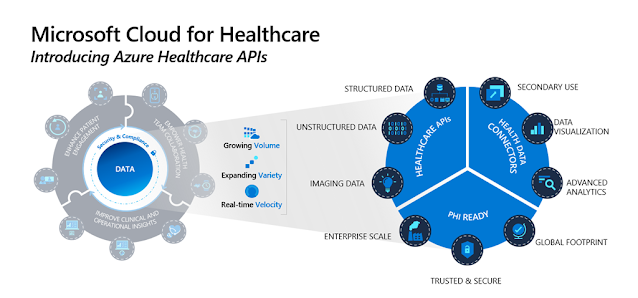Announcing Azure Healthcare APIs
Today Microsoft Cloud for Healthcare is expanding our portfolio of interoperability data services for the health and life sciences industry. In October 2019, Microsoft became the first cloud with a fully managed, first-party service to ingest, persist, and manage structured healthcare data in the native FHIR format with the Azure API for FHIR. Today we’re expanding our health data services to enable the exchange of multiple data types in the FHIR format. For that reason, we’re renaming our services to the Azure Healthcare APIs.
Read More: MS-500: Microsoft 365 Security Administration
Purpose-built for the unique requirements of Protected Health Information (PHI), the Azure Healthcare APIs enable customers to ingest, manage, and persist data in the Microsoft Cloud for Healthcare. Anyone working with health data can leverage the Healthcare APIs to bring disparate sets of PHI together and connect it end-to-end with tools for machine learning, analytics, and AI.

Making real-world data accessible
“Give me all the medications prescribed and all the CT scan documents and their associated radiology reports for any patient older than 45 that has had a diagnosis of osteosarcoma over the last 2 years.”
The above statement is a common request to health data managers. It may come from doctors doing clinical research or data scientists, but we heard from many that filling this type of request, especially across large databases, could take months. Why Because most health systems need to query multiple data stores that don’t speak the same language, then extract the data files, and finally work to unify them in a batch for the user. Structured data like medications, diagnosis, and patient attributes might be stored in pharma or EHR databases, CT Scans are stored in the DICOM format, and radiology reports might be stored as unstructured text. By the time all the data is pulled, the information is stale.
Azure Healthcare APIs enable search and customizable queries like the one above to be filled in minutes. When you ingest and transform data from your systems of record through Azure Healthcare APIs, data is unified to create a longitudinal patient record with real-time data, collected and persisted in a consistent way according to common health data standards across multiple types of health data
◉ Structured inputs like clinical records in HL7 or C-CDA, data from medical devices, services such as HealthKit and Google Fit, or genomics databases, can be ingested, transformed, and mapped to FHIR.
◉ Unstructured data can be mapped to natural language processing algorithms like
Text Analytics for Health to annotate data from clinical notes or text documents and structure it in FHIR so it can be viewed alongside structured clinical data.
◉ Imaging data in
DICOM formats can be ingested through an API gateway, and DICOMCast technology will extract relevant metadata from images and map it to patient records in FHIR.
◉ Biometric data from devices can be ingested through our Azure IoT Connector for FHIR and can provide important information on health trends to care teams to allow for timely interventions and remote care.
Empowering real-world data to fuel real-world evidence
As we look to the future of the health industry, enabling searchability across your systems of record is a powerful starting point, but Azure Healthcare APIs go beyond data ingestion and management to accelerate what you can do with data in the cloud. Clinical inputs can be blended with other patient-based “big data” sets like social determinants of health. As real-world data plays an increasing role in health care decisions, Azure Healthcare APIs empower your data to support Real-world evidence pipelines such as support for coverage decisions, clinical trials pipelines, and observational studies.

Azure Healthcare APIs give you control over where your data goes and how it’s accessed through role-based access control. Streamlined connectors allow you to quickly export data for deep learning and AI frameworks in Azure Data Science VMs or Azure Synapse. If you are preparing data for secondary use,
Tools for Anonymization allow you to rapidly de-identify blended data sets and quickly spin up workspaces for research. Data Science workloads are simplified with automated methods to encrypt, substitute, crypto-hash, perturb, date-shift, and generalize, and templates are available to apply expert determination.
Transforming your organization through real-world action
We’re excited to make it easier to develop AI with health data, but even more important to the future of healthcare is how Microsoft Cloud for Healthcare empowers you to scale it. As you illuminate new insights with your data, it’s easy to quickly connect to, or to connect your data and AI outputs through FHIR APIs or SMART on FHIR back into the systems your teams use on the front lines. That means you’re putting your data in the hands of your team to illuminate new pathways, create new innovation, and deliver real-world action that transforms the way you deliver health.
Empowering our partners and customers
What’s most exciting about today’s announcement is the speed of innovation and impact our partners and customers are finding in Azure Healthcare APIs technology. Slawek Kierner, SVP of Enterprise Data & Analytics, and Cille Kissel, Lead Product Manager, both at Humana and Dr. Casey Taylor from John Hopkins University will be joining us at HIMSS this week to share the powerful transformation they are driving in their organizations and in their research with Azure Healthcare APIs.
Doing more with your health data in the cloud
Simply put, Microsoft Cloud for Healthcare empowers healthcare organizations to do more with their data. Whether it’s transforming the patient experience, creating collaborative workspaces for research teams, or quickly connecting to powerful analytics and visualization tools, it all begins with Azure Healthcare APIs.
Source: microsoft.com






0 comments:
Post a Comment